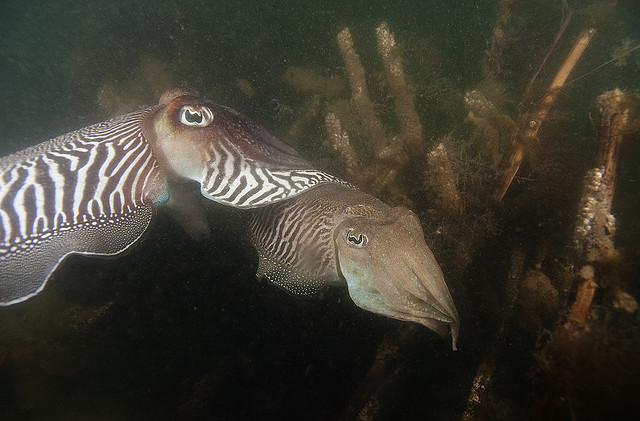Form and Function
The common cuttlefish (Sepia officinalis) is a highly mobile
invertebrate (Ikeda 2009). Because cuttlefish have no shell,
they have acquired strong muscles that allow them to travel for
long distances and hunt aggressively. The common cuttlefish is a
certain type of mollusk that is part of the group called Coleoid
Cephalopoda, along with the
octopus and squid (Fluckiger et al. 2008). Cuttlefish have
some unique characteristics including their skin,
nervous
system, arms and tentacles,
cuttlebone, heart and blood, and
eyes.
SKIN
Another important characteristic of
cephalopods are their
body-patterning techniques. They change their body color and pattern
by neutrally controlling their color pigments (called
chromatophores) so they can blend into their surroundings, stun
prey, or even warn off
predators (Ikeda 2009). They can also change
the physical texture of their skin to match their surroundings
(Kelman et al. 2008). This body-patterning technique can also be
used as defensive camouflage to hide from predators or intimidate
them, and males use it to compete with other males for the female
(Ikeda 2009). When a male wants to impress a female, he will often
display a zebra-like pattern, like in the picture shown below (NOVA
2007).
NERVOUS SYSTEM
Cephalopods have a highly developed nervous systems. In fact,
they have brains the size of some vertebrate brains (Ikeda 2009;
NOVA 2007). The nervous system includes a variety of senses
including sight, smell, and even sound ( in the form of pressure
waves) (NOVA 2007). The nervous system of the coleoid cephalopods is
composed of the optic lobes, the nervous system of the arms, and the
central brain. The optic lobes and the nervous system of the arms
lie outside of the brain capsule. The central brain surrounds the
esophagus and lies inside the brain capsule (Ikeda 2009). The brain
is composed of several lobes (basal, superior frontal, and
vertical), each of which control different types of behavior (Ikeda
2009). Their large brains allow them to recall information and learn
(Ikeda 2009).
ARMS AND TENTACLES![By Hans Hillewaert (Own work) [CC-BY-SA-3.0 (http://creativecommons.org/licenses/by-sa/3.0)], via Wikimedia Commons](HANS.jpg)
The Cuttlefish has eight arms that are used for grasping
prey,
and two long tentacles that shoot our from internal pockets to
capture prey. Cuttlefish also wave their arms in such a way that
lures in prey. Males have a modified arm that is used to transfer
spermatophores into the buccal area of the female (NOVA 2007).
CUTTLEBONE
The cuttlebone is what makes a cuttlefish a cuttlefish, and it is
used like a swim bladder that helps the organism control buoyancy.
The cuttlebone is rich in calcium, therefore, once the cuttlefish
dies its skeleton is sought after by other organisms for its
nutrients (NOVA 2007).

HEART AND BLOOD
Cuttlefish have three hearts! Two of these hearts are for pumping
blood to the gills, and the other heart circulates the blood around
the rest of the body. Want to know something interesting about their
blood? It is GREEN! The copper-containing molecule called hemocyanin
is responsible for this color, and is present in all
cephalopods.
The hemocyanin functions a lot like the hemoglobin in humans; It
transports oxygen (NOVA 2007).
 EYES
EYES
Even though cuttlefish are colorblind, they still have incredible
eyesite; They can see in all directions. With their "W" shaped
pupil, they can see well in low light, and even detect polarized
light! Unlike us, the morphology of their eye allows them to
increase the magnification of the object they are looking at; All
they have to do is alter the shape of their eye (NOVA 2007).
If you are wondering about how this awesome invertebrate came to be, visit the life history/reproduction page!
![By Parent Géry (Own work) [Public domain], via Wikimedia Commons](travelportal/images/newheader.jpg)
